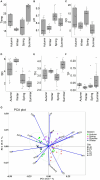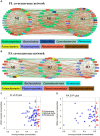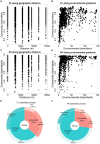Seasonal dynamics of free-living (FL) and particle-attached (PA) bacterial communities in a plateau reservoir
- PMID: 39101032
- PMCID: PMC11295932
- DOI: 10.3389/fmicb.2024.1428701
Seasonal dynamics of free-living (FL) and particle-attached (PA) bacterial communities in a plateau reservoir
Abstract
In terms of lifestyle, bacterioplankton can be classified as free-living (FL) and particle-attached (PA) forms, and both play essential roles in biogeochemical cycling in aquatic ecosystems. Structure, distribution, and community assembly of FL and PA bacteria in plateau riverine waterbodies are largely unknown. Therefore, we explored the seasonal dynamics of FLand PA bacterial communities in the Wujiangdu reservoir, Yungui Plateau using 16S rRNA gene high-throughput sequencing. Results revealed there was a significant environmental heterogeneity in Wujiangdu reservoir seasonally. The dominant phylum was Actinomycetota for FL and Pseudomonadota for PA bacteria. Species richness and diversity was higher in autumn and winter compared to spring and summer. In general, PA diversity was greater than FL, but with some temporal variations. Species turnover was the major contributor to β-diversity of both FL and PA lifestyles, and significant differences were noticed between FL and PA bacterial community composition. Distinct co-occurrence network patterns implied that more connections exist between FL bacteria, while more complex PA networks were in parallel to their greater diversity and stronger interactions in biofilms on particles. Dispersal limitation was the major driving force for both FL and PA bacterial community assembly. Deterministic processes were of relatively low importance, with homogeneous selection for FL and heterogeneous selection for PA bacteria. Temperature was the most important environmental driver of seasonal bacterial dynamics, followed by nitrate for FL and Secchi depth for PA bacteria. This study allows for a better understanding of the temporal variability of different bacteria lifestyles in reservoirs in the vulnerable and rapidly changing plateau environment, facilitating further microbial research related to global warming and eutrophication.
Keywords: Wujiangdu reservoir; Yungui plateau; co-occurrence network; deterministic or stochastic processes; temporal bacterial dynamics.
Copyright © 2024 Yang, Chen, Yao and Grossart.
Conflict of interest statement
The authors declare that the research was conducted in the absence of any commercial or financial relationships that could be construed as a potential conflict of interest.
Figures








References
-
- Akins L. N., Ayayee P., Leff L. G. (2018). Composition and diversity of cyanobacteria-associated and free-living bacterial communities during cyanobacterial blooms. Ann. Microbiol. 68, 493–503. doi: 10.1007/s13213-018-1354-y - DOI
-
- Anderson M. J., Gorley R. N., Clarke K. R. (2008). PERMANOVA + for PRIMER: Guide to software and statistical methods. Plymouth: PRIMER-E.
-
- APHA [American Public Health Association] (2012). Standard methods for the examination of water and wastewater. 22nd Edn. Washington (DC): American Water Works Association and Water Pollution Federation.
LinkOut - more resources
Full Text Sources

